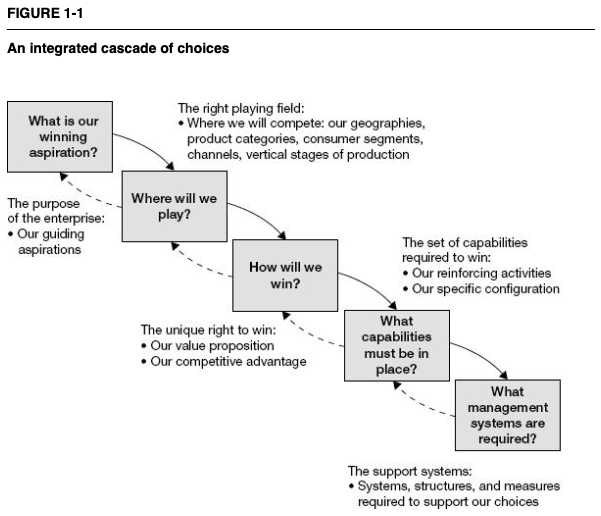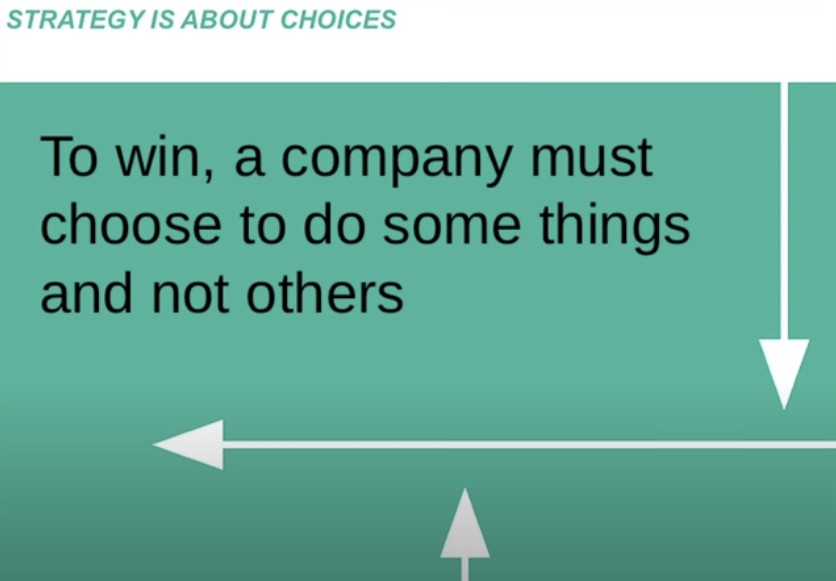Annual planning is usually around the corner this time of year. I find that this is most common for product teams in large organizations that follow an annual financial planning model. May→ kick-off. June → create list. July → do business cases and stack ranking. Aug → negotiate the list. Sep → negotiate again but with half the budget. Oct → pray that the deal is not altered any further.
I have been reading Playing to Win. It is a business book but it is an easy read. It defines strategy as a coordinated and integrated set of five choices: [1] a winning aspiration, [2] where to play, [3] how to win, [4] core capabilities, and [5] management systems. The book takes you through examples of how companies were successful in each of those choices.

I wanted to take the easy way out and looked for popular YouTube videos on “Playing to Win”. The most popular video with the author, Roger L. Martin. You can skip it if you read the book.
There were some examples that were shared by the author that were not in the book. I have written notes and shared them below.
| Choice | Example |
|---|---|
| A Winning Aspiration | GM sells a mid-size car called the Malibu, which is in the same car category as the Camry or Accord. In 2006, GM sold 60,000 Malibu’s and wants to double the sales for next car. However, in the same year, Toyota sold 560,000 Camrys and Honda sold 440,000 Accords. So, this goal was to sell from 1/10 as to 1/5 from the leader, which is not aspirational. GM adjusted its winning aspiration to build a car that Car and Driver, Road & Track, or Consumer Reports, say that this car is as good or better than the Camry. GM researched car scoring criteria, found 9 criteria that needed improvement, mobilized its organization to redo the Malibu (3 teams, back-to-back, 24x7, 7 months, $300M). The new Malibu was launched in 2008 to high praise from The New York Times, Car and Driver, Motor Trend. The redesigned Malibu sold more than 50% more units in 2008 than in 2007, increasing GM’s mid-size market share to 8.4% from 5.7%, while the Camry and Accord percentages remained flat at about 21% and 17.5%, according to GM. |
| Where to Play | Intuit had increasing calls from customers complaining about their Quicken personal finance software because it did not have “double-entry- accounting. Intuit wondered what would happen if their where to play includes business finance. QuickBooks was launched and now holds a vast majority of the market. |
| How to Win | Starbucks Third Place Policy refers to another place outside the home and work that people can gather and build a sense of community. The concept is a cornerstone in the creation of Starbucks’ image of a coffee chain where people are willing to pay a bit more for coffee because of the potential connection that comes with the purchase. |
| Core Capabilities | Burberry wanted to win with young luxury goods buyers. Investments into innovative capabilities like omnichannel, personalization, and in-store digitization, played into how Burberry was able to appeal to younger shoppers around the world. |
| Management Systems | Four Seasons hotels how to win is to have better service than anybody else. They built a “glitch report” system to make sure that the service is outstanding . If any guest is upset about anything, it is recorded as a glitch. Every morning, the entire hotel staff meets to go over the report and the service recovery plan for each glitch. Furthermore, if a hotel manager has zero glitches, they get fired. It meant that the manager lowered the bar so much, such that they do not have any glitches. Eliminating glitches is not the goal. |
Summary
The “Playing to Win” strategy framework is an integrated cascade of 5 choices. Any organization that tries to do a little bit of everything is not going to get very far. You have to pick in a way that will enable you to win. That is the essence of strategy.
